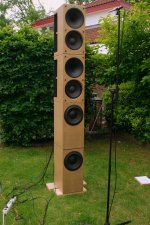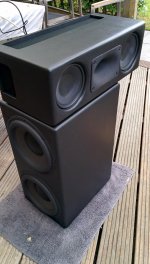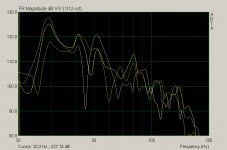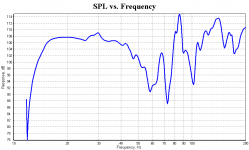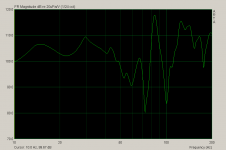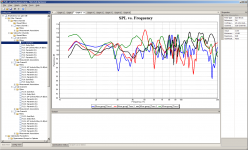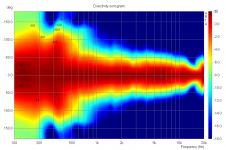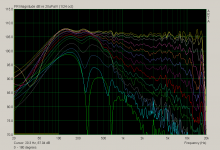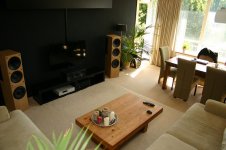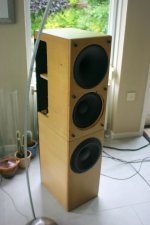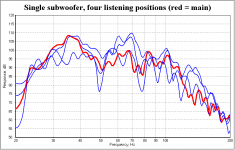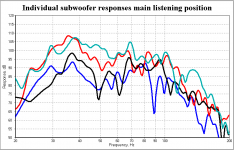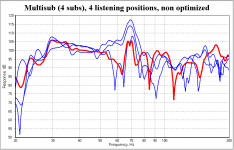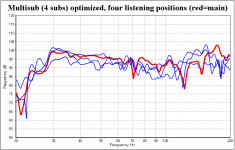Im trying to find software that can run simuliotions based on measurements of my four subs as I'm having a hard time optimizing all parameters for multiple locations. I stumbled upon multi-sub optimizer on Andy's Site of Audio and Electronic Design Topics which I'm very eager to try. However I cannot find this freeware software. Does it even exist (holy grail  )?
)?
You're absolutely right, here is the url link.
The software you mention looks neat, only i'm looking for software to optimize the dsp parameters of the individual subs (gain, eq, delay). I was thinking about this for some time, in the sense that i thought it would be perfect to have software optimize these parameters for you based on measurements of the individual subs. Then i stumbled upon this software which does exactly this and even for multiple locations ! But maybe this is too good to be true and im looking for the holy grail
! But maybe this is too good to be true and im looking for the holy grail 
It appears that Andy_C has been banned for some time on diyaudio. Can anybody help to contact him?
The software you mention looks neat, only i'm looking for software to optimize the dsp parameters of the individual subs (gain, eq, delay). I was thinking about this for some time, in the sense that i thought it would be perfect to have software optimize these parameters for you based on measurements of the individual subs. Then i stumbled upon this software which does exactly this and even for multiple locations
It appears that Andy_C has been banned for some time on diyaudio. Can anybody help to contact him?
Last edited:
I know that Earl Geddes has a routine (Matlab-based?). maybe he could sell you a one-time service where you take the measurements as per his instructions and he runs the script for you?
I also would not mind learning a bit more about sub integration and how others are going about it? so i hope others dial in on your thread here.
I actually bought 4 of Earl's sub drivers (B&C 12TBX100) and I believe he said he would help me setup. however, I am not quite there, may not even get there since I am limited as to where i can put the subs around the room. I made two subs as per Beyma design, "Sub12" here:
http://www.beyma.com/uploads/descargas/1399359845.pdf
but they did not integrate well with my mains (Elsinores) until I removed one. the remaining one just blended in perfectly. I wish i could bring the other one in and move it around for an even better fill in effect but currently it's a no go . I am thinking of doing a sealed design now and maybe than revisit the multi-sub concept.
. I am thinking of doing a sealed design now and maybe than revisit the multi-sub concept.
I also would not mind learning a bit more about sub integration and how others are going about it? so i hope others dial in on your thread here.
I actually bought 4 of Earl's sub drivers (B&C 12TBX100) and I believe he said he would help me setup. however, I am not quite there, may not even get there since I am limited as to where i can put the subs around the room. I made two subs as per Beyma design, "Sub12" here:
http://www.beyma.com/uploads/descargas/1399359845.pdf
but they did not integrate well with my mains (Elsinores) until I removed one. the remaining one just blended in perfectly. I wish i could bring the other one in and move it around for an even better fill in effect but currently it's a no go
I have dine some tests with multisubs in a square room.
The results corresponds very well with room eq whizzard multisub optimizer. I was quite suprised how the subs can cancel each other out if not placed propperly and not exactly similar
I was not suprised how the room is forming the frequency responce.
As you know more subs make a larger sweetspot with even responce if placed propperly. Ref Harman multisub white paper.
The results corresponds very well with room eq whizzard multisub optimizer. I was quite suprised how the subs can cancel each other out if not placed propperly and not exactly similar
I was not suprised how the room is forming the frequency responce.
As you know more subs make a larger sweetspot with even responce if placed propperly. Ref Harman multisub white paper.
Andy C was so kind as to provide me with his program. He has put quite some effort in it, and that worked out really well.
Before the variation was quite large. I did measurements, dual channel, of 5 listening positions of the 4 subs individually. I imported those in multi sub optimizer. It took me a couple runs to get it right. After entering all values into my Hypex DSPs, i did a measurement to check the accuracy of the simulation. Attached is the simulated response of the least important listening position (i left my mic standing there, so it was the most accurate comparison).
(i left my mic standing there, so it was the most accurate comparison).
Also attached are the simulated responses of the four main listening positions. Im very pleased with the results, much better than before. The LF sound well controlled and when needed powerful. And much less variation when you walk through the room.
Before the variation was quite large. I did measurements, dual channel, of 5 listening positions of the 4 subs individually. I imported those in multi sub optimizer. It took me a couple runs to get it right. After entering all values into my Hypex DSPs, i did a measurement to check the accuracy of the simulation. Attached is the simulated response of the least important listening position
Also attached are the simulated responses of the four main listening positions. Im very pleased with the results, much better than before. The LF sound well controlled and when needed powerful. And much less variation when you walk through the room.
Attachments
The program can be downloaded here. If the chm file shows up empty, please read this. The help section can also be found here. Andy will continue to work on the program and add new features. Opening a .msop file (multi sub optimizer project file) created with a newer version than your own,might not work properly.
Haha, actually it was at my dad's house  . Good occasion to visit your parents
. Good occasion to visit your parents  . I didn't actually that much level to do my measurements. For optimizing the stuffing of the damped u frame, i used ground plane measurements. However, for a 360 full range polar of the final result, i had to put all cabinets (that were just finished) on top of each other. And then i had to turn them in 10 deg increments without overturning this enormous pile of speakers
. I didn't actually that much level to do my measurements. For optimizing the stuffing of the damped u frame, i used ground plane measurements. However, for a 360 full range polar of the final result, i had to put all cabinets (that were just finished) on top of each other. And then i had to turn them in 10 deg increments without overturning this enormous pile of speakers  .
.
Did you read the help section? You need to have dual channel measurements at your listening positions, of all subs and mains one by one. Myself, i did the measurements with the dsp at unity gain, no filters active. I did set a high pass to the mains, as i didn't want to change that setting.
It helps to use names like pos1 - sub1.frd. I did all measurements in Arta and immediately exported them in frd format leaving my cursor at 0 ms. Importing the measurements is easy. But it takes some time to set up your configuration as you have to define all of your available filters for each dsp channel and also put limits to them. For instance setting a max gain to smallish subwoofer so it doens't get overloaded . I also dived the PEQs into different frequency bands. Otherwise it would put PEQs at the same frequency.
. I also dived the PEQs into different frequency bands. Otherwise it would put PEQs at the same frequency.
After a few runs, you'll probably change some of the limits to the filters, or maybe fix some of them.
Did you read the help section? You need to have dual channel measurements at your listening positions, of all subs and mains one by one. Myself, i did the measurements with the dsp at unity gain, no filters active. I did set a high pass to the mains, as i didn't want to change that setting.
It helps to use names like pos1 - sub1.frd. I did all measurements in Arta and immediately exported them in frd format leaving my cursor at 0 ms. Importing the measurements is easy. But it takes some time to set up your configuration as you have to define all of your available filters for each dsp channel and also put limits to them. For instance setting a max gain to smallish subwoofer so it doens't get overloaded
After a few runs, you'll probably change some of the limits to the filters, or maybe fix some of them.
Attachments
Little side project. Friend asked me to assemble a new audio set for him, budget of 2.000euro. No DIYaudio, but still interesting because i used half of the budget for a multi sub setup using four active Jamo 10inch BR subs (basically because they were extremely affordable) and a mini dsp with 4way advanced plugin (mains are JBL LS308s, very nice speakers and unbeatable price/performance, you can't build anything near it for that money).
It's a nice real life example why a single sub normally won't give satisfying results. In the attached graphs you can see the measured responses of the 4 individual subs which were spread around the room at the main listening position. 10+ dB difference in their responses. You can also see the amplitude response of a single sub at the four listening positions and you can see that you'll have very different bass response at every seat.
Four subs simultaneously without any form of optimization results in more flatness and less seat-to-seat variation. But the 2nd order axial mode is very present still at 70Hz (subs were all positioned against the wall so this is to be expected).
The results after optimizing gain, delay and 2 PEQs per sub results in more flatness and less seat-to-seat variation. Takes some time to get all the measurements in (24 measurements, 30seconds of pink noise per measurement (128K sequence length, 8K sample freq). But it was worth it
It's a nice real life example why a single sub normally won't give satisfying results. In the attached graphs you can see the measured responses of the 4 individual subs which were spread around the room at the main listening position. 10+ dB difference in their responses. You can also see the amplitude response of a single sub at the four listening positions and you can see that you'll have very different bass response at every seat.
Four subs simultaneously without any form of optimization results in more flatness and less seat-to-seat variation. But the 2nd order axial mode is very present still at 70Hz (subs were all positioned against the wall so this is to be expected).
The results after optimizing gain, delay and 2 PEQs per sub results in more flatness and less seat-to-seat variation. Takes some time to get all the measurements in (24 measurements, 30seconds of pink noise per measurement (128K sequence length, 8K sample freq). But it was worth it
Attachments
Impressive results. How did you go about optimising? - the last graph shows much better consistency than the 3rd one, so I assume you applied different EQ/delay to different subs.
Chris
Actually the purpose of MSO is to derive optimal individual filters to every sub channel. So i defined 4 DSP channels for the subs. Each channel had one gain, delay, a 4th order HP and a 2nd order LP and finally two PEQs available. I setup limits for the settings of these filters. For instance, the 4th order HP was fixed to 25Hz (just there to limit excursion). PEQs can only have negative gain, delay had to be in the range of 0 - 7,5ms.
After you setup the filter channels, you define measurement groups (= listening positions) and finally setup the options for optimization (which range to optimize, a target curve, how to derive the reference level). After that you run the optimization for as long as you allow. And MSO runs different filter settings in order to minimize the frequency response error.
I moved into my new house 8 months ago and made some changes in my own multi sub setup. I now have four identical dual XLS10 sealed subs. Changed from amplification to a more easy to use miniDSP in a box and a(n extra) surround receiver which is dedicated sub amp.
I did measurements at four listening positions. There are four DSP/amp channels with one sub connected to each. See individual subs @ main listening position for the response of the four individual subs at the main listening position (before optimization). MSO optimized their individual filters. See attached screenshot for the filter responses. Also attached is a screenshot of the response at position one, simulated and measured. There are some small differences in the 100-200Hz range, for the rest the match is good.
Finally you can see the end result in the picture showing the 4 amplitude responses, with the main listening position as thick red line, after optimization.
I did measurements at four listening positions. There are four DSP/amp channels with one sub connected to each. See individual subs @ main listening position for the response of the four individual subs at the main listening position (before optimization). MSO optimized their individual filters. See attached screenshot for the filter responses. Also attached is a screenshot of the response at position one, simulated and measured. There are some small differences in the 100-200Hz range, for the rest the match is good.
Finally you can see the end result in the picture showing the 4 amplitude responses, with the main listening position as thick red line, after optimization.
Attachments
-
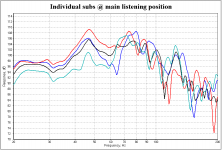 Individual subs.png25.9 KB · Views: 151
Individual subs.png25.9 KB · Views: 151 -
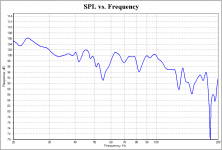 Position 1 simulated.png20.1 KB · Views: 138
Position 1 simulated.png20.1 KB · Views: 138 -
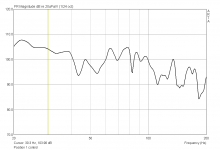 Position 1 control.png29 KB · Views: 183
Position 1 control.png29 KB · Views: 183 -
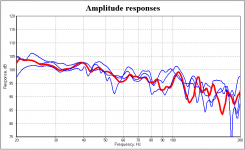 v1.0.png20.5 KB · Views: 345
v1.0.png20.5 KB · Views: 345 -
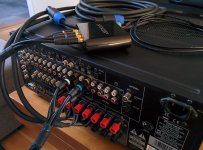 MiniDSP2.jpg817.7 KB · Views: 180
MiniDSP2.jpg817.7 KB · Views: 180 -
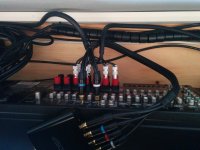 MiniDSP1.jpg824.1 KB · Views: 185
MiniDSP1.jpg824.1 KB · Views: 185 -
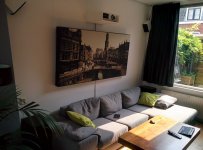 Bank.jpg651.4 KB · Views: 200
Bank.jpg651.4 KB · Views: 200 -
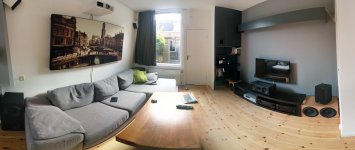 Overview.jpg940.6 KB · Views: 234
Overview.jpg940.6 KB · Views: 234 -
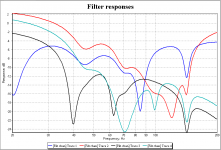 v1.0 filter responses.png28.9 KB · Views: 156
v1.0 filter responses.png28.9 KB · Views: 156
I would need some help if possible.
Mains connected to AMP which has HPF @100Hz (fixed) 24dB/octave.
Two subs under mains are connected to line level out of the AMP (full range signal) and there is miniDSP in between.
Goal: Optimize subwoofers only.
This is what I did:
1. miniDSP set to mono. I assumed I should use mono (this is MSO requirement) and miniDSP would merge L and R inputs for outputs, correct?
2. I did the setup in REW as per requirements and performed five measurements.
Example of one position measurement:
a) Subs off, Mains both, reference Main Right
b) Sub L on, Sub R off, Main L off, Main R on (main R is on as I used it as a time reference speaker)
c) Sub L off, Sub R on, Main L off, Main R on (main R is on as I used it as a time reference speaker)
Basically I ended up with three measurements per position.
I used 12 PEQ, LPF 24 dB/octave and a Delay filters per channel, but Delay was only applicable to one Sub channel.
As there is only one Delay filter, should I apply it on both subs or only one?
Is this a good approach?
I was somehow under impression I would be able to add Mains measurements as well, and than make subs only correction, but the tool would take Mains into consideration.
Can someone tell me if my approach is ok I should do it some other way?
Mains connected to AMP which has HPF @100Hz (fixed) 24dB/octave.
Two subs under mains are connected to line level out of the AMP (full range signal) and there is miniDSP in between.
Goal: Optimize subwoofers only.
This is what I did:
1. miniDSP set to mono. I assumed I should use mono (this is MSO requirement) and miniDSP would merge L and R inputs for outputs, correct?
2. I did the setup in REW as per requirements and performed five measurements.
Example of one position measurement:
a) Subs off, Mains both, reference Main Right
b) Sub L on, Sub R off, Main L off, Main R on (main R is on as I used it as a time reference speaker)
c) Sub L off, Sub R on, Main L off, Main R on (main R is on as I used it as a time reference speaker)
Basically I ended up with three measurements per position.
I used 12 PEQ, LPF 24 dB/octave and a Delay filters per channel, but Delay was only applicable to one Sub channel.
As there is only one Delay filter, should I apply it on both subs or only one?
Is this a good approach?
I was somehow under impression I would be able to add Mains measurements as well, and than make subs only correction, but the tool would take Mains into consideration.
Can someone tell me if my approach is ok I should do it some other way?
Last edited:
Im not sure if you're still interested in my reply, but better late than never
Your measurements appear correct. Im not sure if the miniDSP can sum the L+R inputs to mono.
Furthermore i would a delay block for each sub. And less PEQs, start off with 3 or 4.
Thank you, though.
- Home
- Loudspeakers
- Subwoofers
- Multi-sub optimizer
